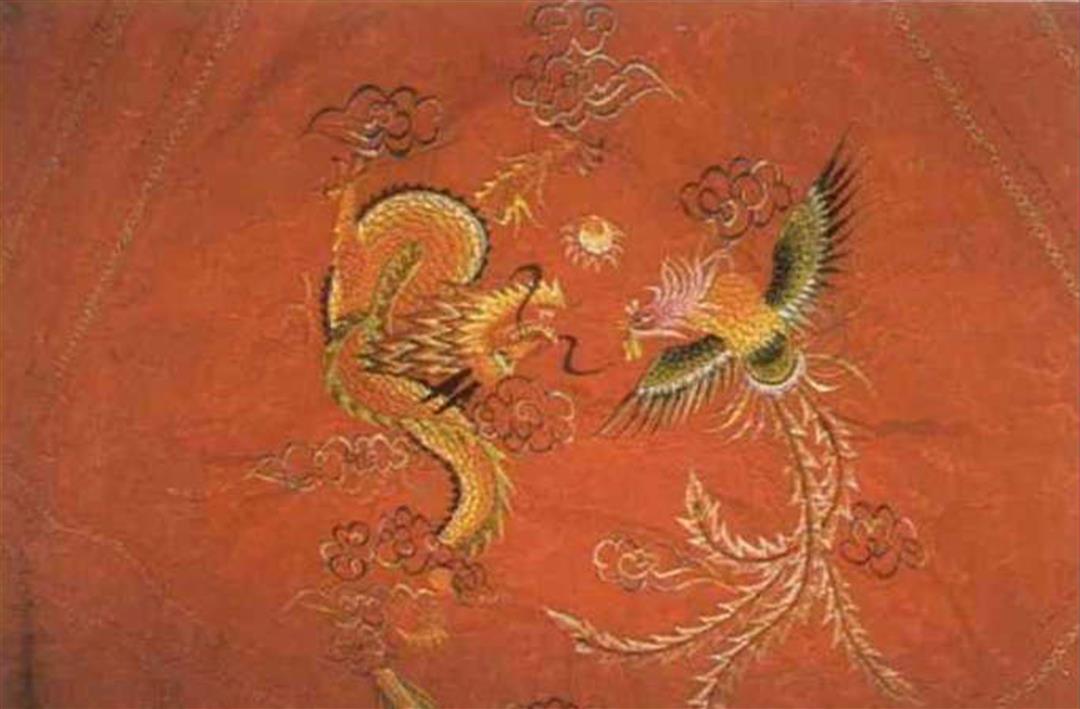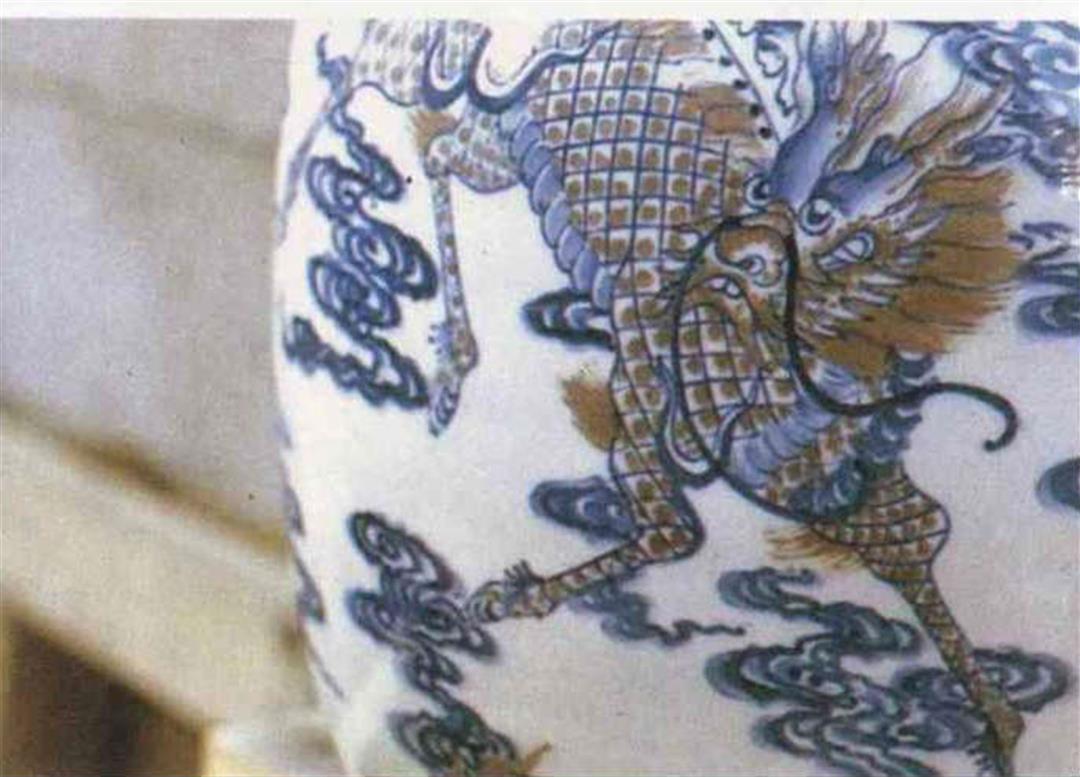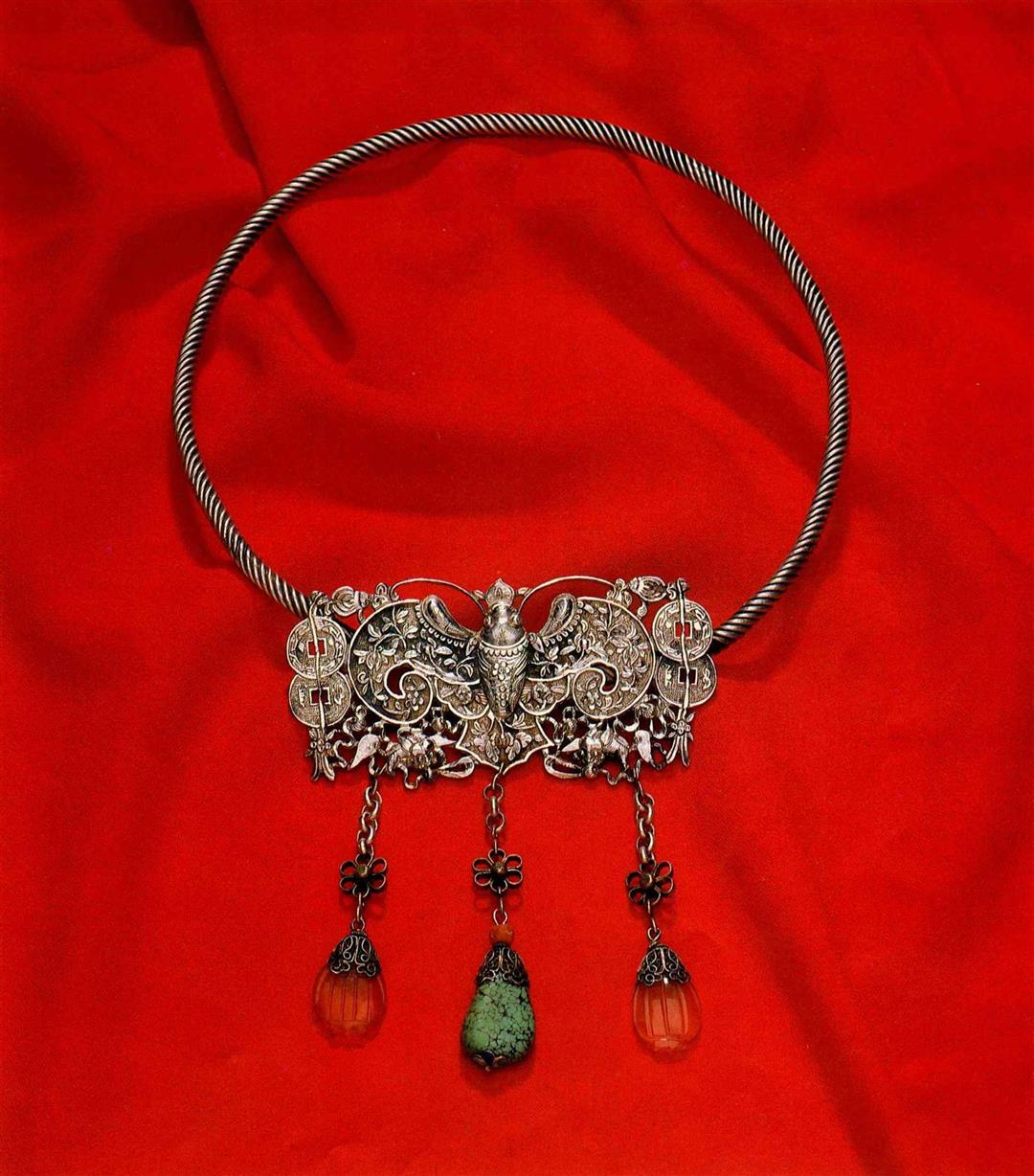In the earliest times, it is said, there was a ferocious creature called the t'aot'ieh, or "gluttonous animal," which had a voracious appetite. Its characteristic vice was also its greatest virtue: because it devoured anything it came upon, even evil spirits avoided it, and the Chinese considered it auspicious. Its fearsome features often appear on ancient bronze or ceramic dining vessels--as a warning against overindulgence as well as a charm against evil.
Similar in function to the t'aot'ieh is the sparrow. To the ancient Chinese its cry sounded like chiechih chiechih, or "Temperance! Temperance!" and so ancient drinking vessels were often formed in the shape of a sparrow or decorated with its image.
The dragon was also considered an auspicious creature, chiefly because it was supposed to bring rain. The emperor was said to be the incarnation of a dragon, and dragons could be depicted only on the robes and articles of the emperor himself or on the ceilings and roofs of palaces and temples.
Long-lived plants and animals, such as pine trees, plum trees, cranes, and tortoises, were naturally considered symbols of longevity, while other plants were deemed auspicious owing to their form: the pomegranate stood for numerous offspring because of its many seeds, for example.
Besides legends and perceived characteristics, another source of auspicious designs was homonyms and word play: In Chinese, the word for quail sounds like peace (an), monkey like marquis (hou), fish like abundance (yu), bat like fortune (fu), deer like prosperity (lu), cassia like nobility (kuei), lotus like succession (lien), onion like intelligence (ts'ung), elephant like propitiousness (hsiang), and tangerine like luck (chi). The Chinese name for magpie (hsich'ueh) contains the word happiness (hsi), and that for bulbul (pait'ouweng) the words "white hair" (pait'ou), implying long life.
The spread of religion broadened the subjects available for auspicious designs. The Eight Tones (named for eight musical instruments used in chanting the scriptures) and the Eight Immortals, for instance, derive from Buddhism and Taoism.
Whatever the source, auspicious designs were visible almost everywhere on the objects of daily use and the architecture of traditional China, and they played an even more important role at weddings, at the birth of a child, at New Year's, and on other special occasions.
Clothing, shoes, and fashion accessories were often embroidered with bats (fu), peaches (shou t'ao) and a pair (shuang) of old coins (ch'ien) to depict a visual pun: "fortune (fu) and longevity (shou) both (shuang) complete (ch'uan)." Hibiscus and peonies stood for glory, splendor, wealth, and rank. And tea sets, wine vessels, canisters, and dining ware were often decorated with a pair of persimmons and a lily or a Chinese evergreen to signify, "May all go as you wish."
Auspicious designs were carved and painted on the doors, windows, pillars, beams, and rafters of traditional Chinese buildings to create a richly ornamental effect.
The Eight Immortals voyaged across the ocean to attend a birthday celebration for the Queen Mother of the West at the Jasper Pool, and so a picture of "the Eight Immortals crossing the sea" represented longevity.
A carp leaping over Lungmen, or Dragon Gate, signified high success in the imperial examinations. Of the 360 carp that were said to swim up the Yellow River each year, only one would be able to leap over the falls at Lungmen and transform itself into a dragon. The rest would receive a black dot on the forehead and would have to wait to try again another year.
During the Tang dynasty (618 to 907) a picture of a spider on the wall was called "wall money." Because of the way it descends its thread, a spider signified "happiness descending from heaven" or, to the imperial concubines, a nocturnal visitation from the emperor.
Placed in a vase (p'ing), the Chinese rose, which blooms every month, symbolized "peace (p'ing) year-round." A picture of nine quails (an) and a chrysanthemum (chu) meant "living (chu) peacefully (an) for nine generations.
Certain designs were particularly common on special occasions. At engagements, when the two families exchanged horoscopes of the bride and groom, the boxes in which the horoscopes were placed customarily contained a pair of Chinese dates (tsao) and a pair of chestnuts (li), meaning "bear (li) a son soon (tsao)." And a bride's dowry was sure to include a pair of shoes (hsieh) and a bronze (t'ung) plate or mirror, to express the wish that the couple might "grow old in harmony (hsieh) together (t'ung)." The same designs were often displayed on wedding invitations.
The faithful love between Mandarin ducks is a model for human couples. They fly together in pairs, and they shelter one another with their wings at night. If one of them dies, the other refuses to seek a new mate. For this reason the bedcovers and pillow cases of newlyweds were often embroidered with Mandarin ducks to wish them faithful love until death.
A child riding a Chinese unicorn, holding a lotus (lien), and blowing a reed pipe (sheng) meant "the unicorn brings a boy" or "a succession (lien sheng) of noble sons." This design was often engraved on jewelry or drawn on other gifts to celebrate the birth of a child.
Under the imperial examination system, the friends and relatives of a scholar traveling to the capital to take the final examination would customarily present him with a duck as a farewell gift, because the Chinese character for duck contains the phonetic chia, meaning number one or first place. Hospitable innkeepers in the capital would cook pigs' feet (t'i) for the candidates as a sign that their names would be listed (t'i) on the roll of successful candidates. Later, pictures of ducks or pigs were presented as a substitute for the actual objects.
Many traditional designs are still very much a part of Chinese life today. Wedding invitations are printed with a picture of a bronze mirror and a pair of shoes; a picture of the Eight Immortals is hung over the doorway to celebrate a happy event; and a pair of Mandarin ducks is still the most commonly used symbol of marital bliss. Some designs have gradually fallen out of favor: People today no longer hope for numerous offspring, for instance, so designs signifying "a succession of noble sons" are no longer in fashion.
The world of today has created many auspicious symbols of its own. A picture of a speeding car is entitled "all the way without a hitch." Pictures of airplanes, trains, and steamships can all mean "progress." And a picture of a hydrogen balloon may mean "good news from on high."
Concrete images used to convey abstract hopes--the images may change, but the hopes remain the same.
[Picture Caption]
(Previous page) A pair of fish (yu) on a window grille signifies "abundance (yu) every year."
Tradition has it that when male and female lions romp together, their fur rolls into a ball of silk from which a baby lion is born, so silk balls are considered lucky objects. Here a lion treads on a pair of them.
A crimson quilt embroidered with a dragon and a phoenix radiates joy.
A picture of the Eight Immortals draped over a doorway is indispensable at weddings and festivals.
Firecrackers (p'aochu) are set off at Chinese New Year to drive away evil spirits, and the words "bamboo (chu) announces (pao) peace" are printed on the red envelopes filled with cash which are given to children as gifts.
The Chinese unicorn is one of the Four Numinous Creatures. It appears only during a time of world peace or at the birth of a sage.
The Chinese character 回, or "return," is often used as a decorative motif on furniture.
A bat (fu), a vase (p'ing), the character for longevity, and a pair of ju-i symbols on a window lattice signify "good fortune (fu) and longevity as you wish(ju-i)" and "for tune, longevity, and peace (p'ing)."
A pair of dragons, set off by phoenixes and auspicious foliage below, prepare to do battle over a pearl.
Two characters for happiness 喜, set next to each other on a bowl, mean "double bliss." This motif is commonly seen at weddings.
The chain stitched at the top of this tutou, or inner garment, is called a "long life lock." The goldfish and peaches at either side stand for abundance and longevity. Inside the pendant are the three characters for fortune, prosperity, and longevity. Below, a child riding on a cloud holds a ju-i symbol. The whole design conveys some of mankind's most basic hopes.
A t'aichi door handle wards off evil, while orchids and shou stones are full of auspicious significance.
Clouds, which serve as vehicles for immortals and bring nourishment to the world, are a common decoration along the sleeves and hems of traditional Chinese clothing. Dragons and phoenixes are here stitched along the skirt.
The bat (fu), flying elephants, and two pairs (shuang) of old coins (ch'ien) on this silver necklace signify "fortune (fu) and longevity both (shuang) complete (ch'uan)."

Tradition has it that when male and female lions romp together, their fur rolls into a ball of silk from which a baby lion is born, so silk balls are considered lucky objects. Here a lion treads on a pair of them.

A crimson quilt embroidered with a dragon and a phoenix radiates joy.

A picture of the Eight Immortals draped over a doorway is indispensable at weddings and festivals.

Firecrackers (p'aochu) are set off at Chinese New Year to drive away evil spirits, and the words "bamboo (chu) announces (pao) peace" are printed on the red envelopes filled with cash which are given to children as gifts.

The Chinese unicorn is one of the Four Numinous Creatures. It appears only during a time of world peace or at the birth of a sage.

The Chinese character 回, or "return," is often used as a decorative motif on furniture.

A bat (fu), a vase (p'ing), the character for longevity, and a pair of ju-i symbols on a window lattice signify "good fortune (fu) and longevity as you wish(ju-i)" and "for tune, longevity, and peace (p'ing).".

A pair of dragons, set off by phoenixes and auspicious foliage below, prepare to do battle over a pearl.

Two characters for happiness 喜, set next to each other on a bowl, mean "double bliss." This motif is commonly seen at weddings.

The chain stitched at the top of this tutou, or inner garment, is called a "long life lock." The goldfish and peaches at either side stand for abundance and longevity. Inside the pendant are the three characters for fortune, prosperity, and longevity. Below, a child riding on a cloud holds a ju-i symbol. The whole design conveys some of mankind's most basic hopes.

A t'aichi door handle wards off evil, while orchids and shou stones are full of auspicious significance.

Clouds, which serve as vehicles for immortals and bring nourishment to the world, are a common decoration along the sleeves and hems of traditional Chinese clothing. Dragons and phoenixes are here stitched along the skirt.

The bat (fu), flying elephants, and two pairs (shuang) of old coins (ch'ien) on this silver necklace signify "fortune (fu) and longevity both (shuang) complete (ch'uan).".